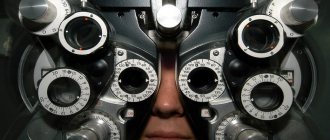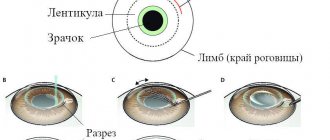Eye pain can be unbearable and can cause severe discomfort. To help the patient, the ophthalmologist can prescribe eye drops with an analgesic effect. They vary in nature and speed of action, but are always aimed at reducing pain. When you can use such tools, read the article.
Let us immediately make a reservation that the use of any painkillers requires consultation with a doctor. Many eye drops that reduce pain have many side effects and can cause complications, some leading to serious consequences for vision. Therefore, you should not self-medicate; you should first visit an ophthalmologist.
Local medications for eye pain relief are divided into two groups - anti-inflammatory and anesthetic drops. The choice of a specific drug is determined by the cause of the pain.
What are pain relieving eye drops?
Anesthetic drops are included in the category of medicines, and therefore must be prescribed strictly by an ophthalmologist and only after the necessary examination. If you have not previously visited your doctor, we strongly do not recommend that you use these remedies. This is largely due to the fact that eye pain-relieving drops cope only with pronounced pain symptoms, but cannot eliminate one or another disease that is their cause. And many patients, in fact, believe that with the help of drops they will be able to recover from one or another ophthalmological disease. As experienced optometrists explain, the action of these drugs is based on the ability to block pain impulses, thereby suppressing the unpleasant sensations that arise in connection with a certain ophthalmological pathology. Simply put, it is no coincidence that pain-relieving eye drops received such a name. They do not cure the disease or relieve the patient from injury. Their task is only to relieve the accompanying symptoms.
Main causes of eye inflammation
The modern pharmaceutical industry is quite well developed. Manufacturing companies regularly supply various medications, including: tablets, capsules, ointments, drops, injection solutions, etc. Some people make a big mistake by starting treatment for a particular disease with antibiotics on their own, believing that they will have a better effect than taking other drugs. Any doctor will tell you that the key to correct and, most importantly, effective therapy lies in the correct selection of medications. And in order to do this, it is necessary to correctly establish what exactly caused the inflammatory process in the eyes.
So, inflammation of our eyes can be provoked by all sorts of factors. The most common of them, according to experts, are:
- allergic reactions;
- infectious eye infections by microorganisms;
- inflammatory diseases, for example: ARVI or influenza;
- injuries to the visual organs.
Depending on what exactly led to the inflammation of the visual organs, the type of drops that will be recommended to the patient by the attending physician also depends.
When are eye pain drops prescribed?
In modern optometry, and especially in ophthalmic surgery, anesthetic eye drops can be used in a wide variety of cases. However, to call them a universal and unmistakably effective remedy in the treatment of a particular pathology or eye injury would be incorrect. They are recommended for:
- preparing the patient for many preventive procedures in ophthalmology;
- before removing foreign bodies from the eyeball;
- to provide pain relief during certain manipulations;
- for the treatment of eye injuries.
In all the cases presented, the use of such drugs is permissible only as prescribed by a doctor. Patients who are thinking about unauthorized use of such drugs should remember that they can cause various severe adverse reactions, including, for example, changes in the structure of the cornea and even complete loss of vision.
Anti-inflammatory drops: specifics of use
Sometimes anti-inflammatory solutions are prescribed to numb the eyes. These can be drops like Diclofenac or Broxinac. They slow down the synthesis of substances that cause pain and inflammation. The effect usually occurs approximately half an hour after instillation. These drops are indispensable in the treatment of scleritis, blepharitis, and various types of conjunctivitis. These drugs are also used in ophthalmic surgery, usually in the postoperative and recovery period.
Drops from this group have a number of side effects. For example, they can reduce visual acuity, so you should not use them unless prescribed.
Please note that you should not use painkillers to relieve discomfort caused by contact lenses. In this case, you need to choose other, more comfortable means of contact correction or use moisturizing solutions.
What are eye anesthetic drops?
Let's look at what types of eye drops exist today. Anesthetic eye drops are divided into two groups. The first includes pain-relieving anesthetic drops. These drugs are capable of blocking nerve conduction for a certain period of time, which usually does not exceed half an hour. This category includes medications such as:
- "Lidocaine";
- "Innocain";
- "Albucid";
- "Furacilin";
- "Alcaine."
Ophthalmic manufacturing companies regularly release new medications, and therefore the list of such drops is constantly updated, and therefore we are simply not able to list all those currently available. We have given as an example only the most popular of them, which have long managed to prove their high effectiveness and receive a huge number of positive reviews from both doctors and patients. If you use eye drops with an anesthetic effect, the pain begins to subside after just a couple of minutes. In ophthalmology, they are used by specialists in the following cases:
- as an “ambulance” for corneal injury;
- when performing a Schirmer test or contact tonometry - various diagnostic procedures;
- in ophthalmic surgery to remove foreign bodies from the cornea.
The decision to prescribe the use of certain eye drops should be made only by the attending physician. Take care of your eyesight and do not self-medicate.
Eye contusion
Contusions or blunt trauma account for almost half of all eye injuries. They often occur in domestic conditions and are considered severe because during a contusion all membranes of the eye are damaged. The injury is sometimes expressed only by hemorrhage, but can be more serious - with destruction of the eyeball and the tissue that surrounds it.
In addition, blunt trauma to the eye can be caused both directly to the eye and surrounding areas of the head, but the organs of vision may also be affected. For example, in the first case, the patient receives a bruise to the eye when hit with a fist, and in the second, the concussion occurs from a blow to the head. An injured person experiences pain, nausea, vomiting, and an abnormal pulse rhythm.
In addition, vision deterioration or complete loss is observed, hemorrhage appears under the skin of the eyelid, the pupil dilates, and tearing of the iris is possible.
As a result of the operations performed to eliminate myopia, another type of eye injury appeared due to contusion. This is a rupture of the stratum corneum under the postoperative scar. Often the result after such an eye injury is hemorrhage and loss of the membranes of the organ of vision. When providing first aid to severe injuries, it is necessary to apply a bandage of clean cloth to the affected area and urgently transport the patient to a medical facility.
What anesthetic drops are used for eye injuries?
Anesthetic eye drops after an injury should only be used under the supervision of a physician. The most common causes of eye injury are the ingress of various foreign bodies, chemical or mechanical substances. It is important to understand that it is strictly forbidden to choose treatment for yourself based on the experience of friends or acquaintances. Only a qualified specialist can prescribe you the appropriate pain-relieving eye drops for an injury. In addition, it is important to consider that not all existing drops for eye injury are equally useful. What exactly caused this condition is of great importance. For example, when foreign bodies get into the eyes, ophthalmologists often prescribe Albucid or Furacilin to their patients. Eye drops for eye injury caused by mechanical or chemical means will be selected completely differently. Experts strongly recommend not to use pain-relieving drops for eye injuries on your own without first consulting a doctor. This is especially true for those situations where the cause of the pain has not been fully identified and additional examination may be required. Uncontrolled use of pain-relieving anesthetic drops in case of eye injury can lead to very negative consequences for the cornea, provoking its serious and, most importantly, irreversible damage.
Symptoms of eye damage
With any eye damage, the following are observed:
- Pain.
- Burning.
- Photophobia.
- Swelling and spasm of the eyelid.
- Redness of the white of the eye.
- Feeling of the presence of a foreign body.
- Tearing.
In this case, symptoms of a specific type of injury are necessarily present. So, during a contusion the following occurs:
- Erosive phenomena on the cornea and eyelid.
- Decreased vision.
- Swelling.
- Purulent discharge.
- Cloudiness and inflammation of the cornea.
- Redness of the sclera.
- Formation of ulcers on the corneal tissue.
The following symptoms correspond to burns:
- Swelling of the cornea.
- Hyperemia of eye tissue.
- The appearance of bubbles.
- Violation of the integrity of the corneal layer.
- In severe cases, necrosis of tissues and structures of the eye occurs.
- A particularly severe degree is destruction of the eye.
Penetrating wounds have the following symptoms:
- The intraocular membranes fall out.
- The iris breaks.
- Hemorrhages appear.
- The lens is damaged.
- Hypotension develops.
Insect contact with the eye causes:
- Severe itching.
- Burning.
- Irritation of the mucous membrane.
In each specific case, it is necessary to provide proper first aid for an eye injury and transport the patient to a special medical facility.
What are non-steroidal eye drops?
The second category is non-steroidal eye drops designed to provide both analgesic and anti-inflammatory effects. The principle of their action differs significantly from that which is characteristic of the anesthetics we previously presented. It consists in reducing the synthesis of substances that provoke pain and cause inflammatory processes in the visual organs. The most popular non-steroidal painkillers are:
- "Diclofenac";
- "Indocollier";
- "Broxinac";
- "Okomistin";
- "Tobrex".
Unlike the anesthetics we described earlier in this article, non-steroidal painkiller drops do not provide a quick effect. In order for them to begin to act, the patient must wait some time, usually about 15-30 minutes. In this matter, everything depends on the individual characteristics of your body. As you understand, the effect of using non-steroidal drops is observed a little later. Ophthalmologists prescribe their use in the following situations:
- after surgical interventions in the eye area;
- to relieve discomfort after LASIK;
- in the treatment of ophthalmological diseases, for example, blepharitis or conjunctivitis.
Eye anesthetic drops included in the non-steroidal category may cause short-term blurred vision or the appearance of spots before the eyes. There is no need to be afraid of this; such a reaction is absolutely normal. It is enough to blink a few times and the effect that occurs after use will stop. Remember that independent use of non-steroidal drops is strictly prohibited. It is important to understand that being a medicine, they have certain contraindications for use. For example, the use of non-steroidal pain-relieving drops is highly discouraged in cases where the patient complains of increased eye sensitivity. In addition, the use of these drugs is prohibited for peptic ulcers and other pathologies of the gastrointestinal tract, as well as during pregnancy and lactation.
MagazinLinz.ru team
Eye burn
In case of a burn to the organs of vision, you should immediately contact a medical professional to provide first aid on the spot, and then take the patient for further treatment to a specialized department. Different types of burns require different actions:
- Thermal. You need to try to remove dirt from the eye (if any) and treat the skin around it with alcohol. Place an ointment containing an antibiotic behind the eyelid. Wrap the ice pack in a cloth and apply it to the eye.
- Chemical. You need to rinse your eye thoroughly with running water. The procedure takes about a third of an hour.
- Ultraviolet. The patient needs to be given painkillers, put antibacterial ointment in the eye, or drop antibiotic drops. Place the patient in a darkened room.
Medical care for an eye injury is provided to the patient in a hospital or on an outpatient basis. It depends on the severity of the injury. Treatment options:
- 1st degree burn. Use: Monomycin, Levomycetin, Furacilin and tetracycline ointment. Treatment is carried out on an outpatient basis.
- Burn 2, 3 or 4 degrees. The patient is admitted to the hospital. Poludan, Vigamox, Colbiocin, Sofradex are used for therapy.
In cases of extensive eye damage, surgical intervention is not necessary. If it is impossible to restore the cornea or lens, the patient is offered implantation.











